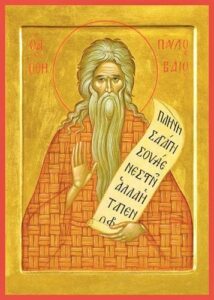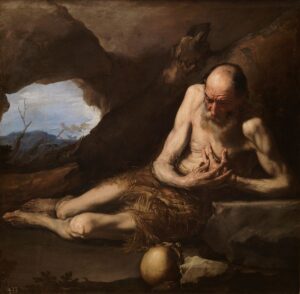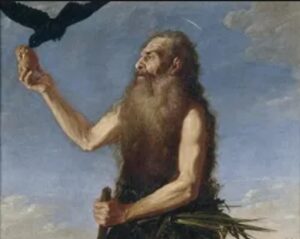St. Paul of Thebes – Jan 15 I First Known Christian Hermit

St. Paul of Thebes, is the first Christian hermit, was born in Thebiad ( Thebes was the first capital of Egypt.), Upper Egypt, about 228/234 A. D. and died about 340. A Christian hermit is the one who chooses to live a solitary life, totally apart and usually in a desert place, for the sake of Christ. St Paul the monk was the first of those men who retired to the desert to spend their lives in solitude, prayer and fasting. He was distinguished from the still earlier ascetics, of whom very little is known. He was soon followed by a large number of such hermits – the most notable amongst them being St Anthony, the Great of Egypt.

He was born to wealthy, aristocratic, landowner parents, who died when he was 15. He was then taken care off by his married sister. He was already well educated in letters, proficient in Greek and Latin and in Christian faith. During the Caesar Decian and Valerius persecution, around 245 – 250 A.D.; when he was about 20 years, he hid in a friend’s farm. Our Lord himself had advised, “When they persecute you in one town, flee to the next.” (Matt. 10:23).
Later his brother-in-law, tried to covet his property and wealth, was about to betray him to the government, Paul fled once more, now to the wild desert. After travelling a long distance, he found a cave wherein he stayed. He retired to a desert cave, and there lived until his death, in constant prayer. He lived by eating dates, from an ancient palm tree and drinking water from a nearby spring and wearing clothes made of palm leaves.
In his fifty third year a raven started bringing him half a loaf of bread. Ravens ministered to him, as to Prophet Elijah. Thus, the life of prayer and penance became St. Paul’s second nature, and he remained in this secret garden of delights for the remaining 90 years of his life. St. Paul was accompanied by two tamed lions, who, when he died in St. Anthony’s presence, clawed into the ground to make his grave.

God did not permit Paul to die utterly unknown to the rest of humankind. When he was 113 years, St Anthony was told in a dream that there was another hermit in the desert more perfect than himself, who had reached the age of 113 years. Anthony rose, took up his staff, and walked straight into the desert, trusting God to lead him where he should go. He was threatened by various beasts sent by the Devil, but he tamed them with the sign of the Cross, and they showed him the way he should go. Finally a wolf brought him to St Paul’s cave.
They embraced as brothers in Christ and spent the night in prayer. St. Paul received in his seclusion Saint Anthony, who was himself 90 years old, whom he trained to become his successor in the establishment of the hermit life. St. Paul had died while kneeling in prayer. While St. Anthony was wondering how to dig the grave without a shovel, two lions came up, mourned over the body of St. Paul, and then dug a grave for him. Their task finished; they came up to Anthony as if to seek a blessing from him. He blessed them and dismissed them. He then laid the aged saint into the grave they had dug. But he kept for himself, as a precious relic, the tunic made of palm leaves that Paul had worn. Ever after, St. Anthony would wear this tunic on the solemnities of Resurrection and Pentecost. Saint Paul is honored as the first desert-dweller and hermit and his day is commemorated by Orthodox and Roman Catholic Church on January 15.
A prayer to St Paul the First Hermit
O God, who willed that St Paul achieved a high degree of sanctity through a life of solitude, prayer and penance in the desert, grant that through his intercession, we, who are striving to develop in ourselves the spirit of prayer and service, may come ever closer to you in love. We ask this through Christ our Lord. Amen
0 Comments